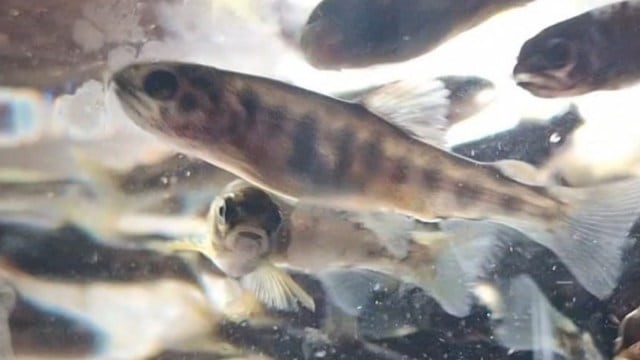Brown Trout

- 17 Sep 2025
In News:
- Kashmir is embarking on a significant initiative to revive its brown trout (Salmo trutta) population, a species first introduced to the Valley by the British in 1900.
- Once a hallmark of Kashmir’s cold-water streams and a popular game fish, the brown trout population had declined over decades due to unregulated angling, habitat degradation, and ecological disturbances.
- The Fisheries Department of Jammu & Kashmir plans to reintroduce the species into streams and lakes, aiming to combine conservation with tourism promotion.
About Brown Trout
- The brown trout is a cold-water, salmonid fish native to Europe, northern Africa, and parts of Asia. It prefers cool, well-oxygenated freshwater streams, often residing in crevices between boulders. Typically, individuals grow 15–22 inches in length and weigh 1–5 pounds.
- Brown trout are renowned as a game fish due to their aggressive and elusive nature, which makes angling challenging and rewarding.
- Globally, brown trout have been introduced widely as a game fish, but outside their native range, they are considered one of the world’s worst invasive species.
- In India, their introduction to Kashmir was facilitated by Frank J Mitchel, a British entrepreneur, and earlier attempts during Maharaja Pratap Singh’s era. The fish initially thrived in streams such as Panzagam, Lidder, Bringhi, and Ferozpora, eventually supporting recreational fishing and angling tourism.
Revival Initiative
The current revival project is supported under Pradhan Mantri Matsya Sampada Yojana (PMMSY) and J&K’s Holistic Agricultural Development Programme, enabling the import of 3 lakh pure brown trout eggs from Denmark. These were hatched at the Tchansar Hatchery in Kulgam, marking a milestone as previous efforts primarily focused on rainbow trout for food production rather than wild trout restoration.
Rearing brown trout posed unique challenges:
- They refuse artificial feed, requiring specially formulated diets of crustaceans mixed with cod liver oil.
- They feed in darkness, prompting hatchery modifications to simulate natural conditions and monitor feeding.
The October–November period, coinciding with their breeding season, was chosen for release as brown trout exhibit lower aggression and reduced cannibalism, increasing survival rates. Streams and lakes targeted for reintroduction include Veshav River and Kounsarnag Lake in Kulgam.
Ecological and Socioeconomic Significance
Reintroduction serves multiple purposes:
- Biodiversity restoration: Revives native aquatic fauna and strengthens freshwater ecosystems.
- Tourism enhancement: Brown trout are a draw for anglers, boosting local tourism and allied services.
- Heritage and culture: The initiative reconnects the Valley with a century-old ecological and recreational tradition.
Experts, however, caution that habitat preservation is crucial, emphasizing the need to control illegal riverbed mining and maintain clean, oxygen-rich streams for the trout’s survival.
Conservation Status and Global Context
According to the IUCN Red List, the brown trout is listed as Least Concern, reflecting its wide distribution and adaptability in native ranges. However, localized conservation efforts, such as this reintroduction in Kashmir, are essential to sustain ecologically and economically significant populations in specific regions.
